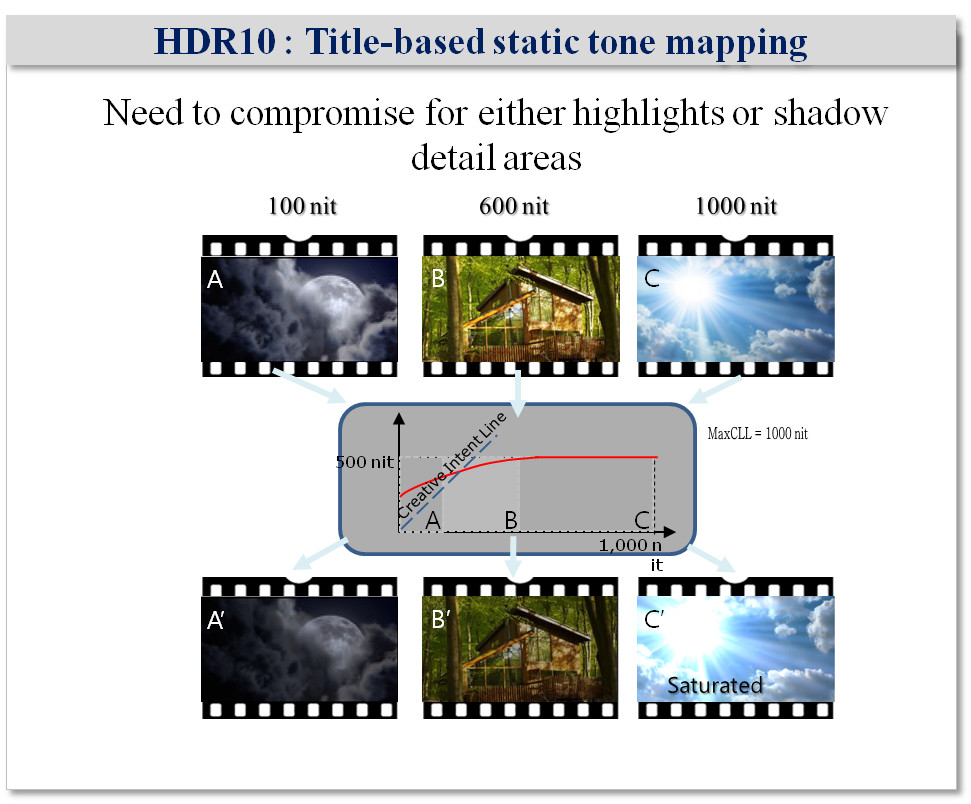HDR10+, the alternative dynamic metadata-based HDR solution to Dolby Vision, was discussed broadly at CES for the first time. It was also bolstered with the addition of Warner Bros. to the initial supporters which include Samsung, 20th Century Fox and Panasonic. (Warner Bros. Home Entertainment Joins HDR10+ Alliance)
The HDR10+ supporters have formed an organization – HDR10+ LLC – to educate and promote this royalty free option, but also to set up a certification and logo program to help ensure high quality implementations.
The HDR10+ platform will soon be available to content companies and manufacturers of ultra-high definition TVs, Blu-ray disc players/recorders and set-top boxes, as well as SoC vendors, royalty-free. In addition, Ultra HD Blu-ray metadata generation tools have been developed with third parties, like ColorFront, which are also now available for content creators enabling Ultra HD Blu-ray players to enter the market.
Details on the content transfer and interface format for the content creation pipeline will be released shortly.
While the HDR10+ LLC does require a licence, it is not based on a royalty. The fee covers administrative costs, access to the specification, and even help to properly implement it. Licensees will also get a test specification, use of patents from the three founders, and the ability to use the new HDR10+ logo once products or content pass the self-certification test.
Companies can learn about the license program, including final specifications and adopter agreements, and sign up to receive a notification when technical specifications for HDR10+ become available at www.hdr10plus.org/
It is important to note that adopters can still innovate in terms of how they implement an HDR10+ solution. Certification will help ensure that certain quality bars are exceeded. More than 25 companies spanning many different industries have expressed strong interest in supporting the HDR10+ platform, further reinforcing its path to success.
“It was important for us to create an open system that is flexible and offers a viewing experience much closer to the filmmaker’s creative intent for the film,” said Danny Kaye, EVP of 20th Century Fox, and Managing Director of the Fox Innovation Lab. “Together with Samsung and Panasonic, we aim to standardize the licensing process making it easy for partners, including content creators, television and device manufacturers, to incorporate this technology and improve the viewing experience for all audiences.”
In late November 2017, Amazon Prime began to stream its full library of HDR 4K content in the new HDR10+ format. So far, only Samsung TVs can support decoding and playback, but Panasonic used CES to announce new TVs and a Blu-ray player that will also support HDR10+ playback in 2018. The Prime Video HDR10+ catalogue includes hundreds of hours of content such as Prime Originals The Grand Tour, Golden Globe-nominated The Marvelous Mrs. Maisel, Jean-Claude Van Johnson, The Tick and The Man in the High Castle plus hundreds of licensed titles.
The addition of a second studio adds a lot of momentum to the standard. Jim Wuthrich, President of the Americas and Global Strategy, Warner Bros. Home Entertainment said that they now have a catalog of over 75 HDR titles and they plan to offer them in the HDR10+ format in 2018.
Creation of the dynamic metadata for the HDR10+ format can be done in an automated fashion with or without intervention by a colorist. This was how Amazon was able to quickly offer their full library in this upgraded format.
HDR10+ is also vying to be adopted in the new ATSC 3.0 over-the-air broadcast standard. It is currently in the Candidate standard status with the goal of moving it to Proposed standard status shortly.
Authoring Developing
We also met with Blu-ray authoring specialist Scenartist at CES. They told us that their new authoring workflow now can support authoring of Ultra HD Blu-ray titles in the HDR10+ format. The Scenartist authoring system is a very popular platform for Hollywood Blu-ray production, so this is an important milestone for the development of HDR10+ Blu-ray discs.
Blu-ray disc author system starts after the content has been mastered and delivered to the authoring facility as a JSON file. The tool set unwraps the JSON file and embeds the dynamic metadata into the SEI part of the HEVC encode. New registers are required to signal the disc has HDR10+ metadata so the player can recognize this and decode it properly.
We also learned that pop-up menus can be an issue with any dynamic HDR solution. Since the tone mapping can change from scene to scene, this can result in “flashing” of the pop-up menu if it continues to be displayed over these changing scenes. The solution is to pause the dynamic tone mapping when pop-ups are displayed.
The deficiencies of HDR10 and the benefits of dynamic metadata in HDR10+ are explaining in the diagrams below.



